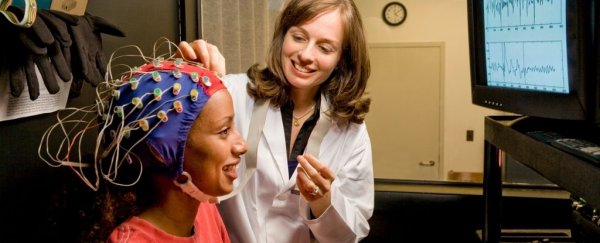New research exploring how people forget things appears to have unintentionally stimulated better memory among its participants.
The experiment was originally conducted in 2012 and was supposed to explore the role of the left dorsolateral prefrontal cortex (DLPFC) in voluntary forgetting.
While the 2012 experiment successfully demonstrated forgetting was something actively managed by the DLPFC, it turns out there was a bonus hidden inside its data.
A reanalysis has now shown that tickling this part of the brain with the right frequency of magnetic stimulation as we learn new material can also help us remember it.
"We were quite surprised when we saw these effects in the first study, which was designed to investigate a different question," says cognitive neuroscientist Simon Hanslmayr from the University of Glasgow.
To test if the results were more than just a fluke, researchers conducted a second experiment. In it, 24 healthy adults were presented with two lists of 10 words that they were asked to memorize. The two lists were shown separately a dozen times.
After a short task designed to distract the participants, the cohort was again asked to recall all the words from the two lists just presented.
While the words were being presented, half the group received a single hertz of slow repetitive transcranial magnetic stimulation (rTMS) to the prefrontal cortex. The other half received a hertz of rTMS to the top of the head.
Compared to participants in the control group, those who received magnetic stimulation to the DLPFC performed better on the memory recall task.
The stimulation didn't seem to help participants remember the order of the words any better, but it did help them remember each word independently.
The new study only included two dozen healthy adults, which means the findings need to be taken with a grain of salt. That said, the results don't stand completely on their own.
Not only do they support findings from the 2014 study, they also fall in line with similar studies exploring DLPFC and its role in memory formation.
Previous studies that have actively stimulated the DLPFC, for instance, have shown a reduction in memory performance. But rTMS is different. This slow type of stimulation seems to have an inhibitory effect on most of the cortex, not an excitatory one.
For those with major depressive disorder, the inhibitory nature of rTMS has even emerged as a promising new treatment to quiet the mind.
These inhibitory effects might even ripple outwards from the DLPFC to a closely connected area, known as the parietal cortex.
This part of the brain is involved in attention and perception, and in brain imaging studies, when activity here is reduced, our focus and memory performance tends to improve.
During the 2012 study, for instance, scientists measured a reduction in electrical activity within the parietal region of those undergoing brain stimulation.
"Our electrophysiological results suggest that frontal stimulation affects a wider network and improves memory formation by inhibiting parietal areas," says neuroscientist Mircea van der Plas from the University of Glasgow.
"These are complex but interesting effects that require further experiments to better understand their neural basis."
The results will need to be replicated among much larger cohorts before we can ascertain how widespread these effects might be.
Recently, however, noninvasive brain stimulation has begun to emerge as a promising new treatment for age-related memory loss and other neurological conditions that impact memory.
Neuroscientists are still trying to figure out which parts of the brain to stimulate and how for the best effects, but progression is slowly being made.
A brain imaging study in 2019, for instance, found multiple sessions of high-frequency magnetic stimulation to the hippocampus improved the neural hallmarks of age-related memory loss. At the same time, behavioral hallmarks of memory loss were also improved among older adults.
Another study in 2014, which targeted the right and not the left DLPFC, also found magnetic stimulation during memory encoding improved memory performance.
Far more research is needed to tease apart the intricacies of magnetic stimulation on memory, but re-analyzing previous datasets and replicating those results could be an important step to finding out more.
The study was published in PLOS Biology.
